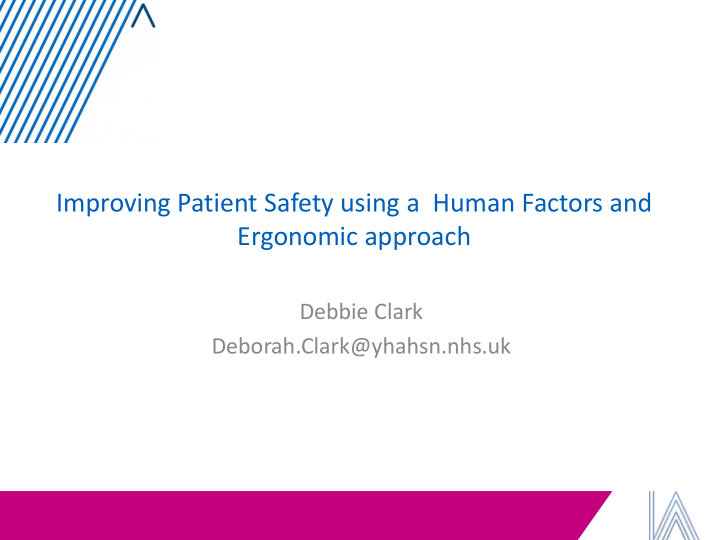



Improving Patient Safety using a Human Factors and Ergonomic approach Debbie Clark Deborah.Clark@yhahsn.nhs.uk
There is a problem. • 1 in 10 patients will suffer adverse events – 50% of the events were preventable. – 33% of adverse events led to moderate, or greater disability, or death DH (2000); Vincent (2006)
Human Fallibility • Healthcare is increasingly complex. • Fallibility makes healthcare professionals (as humans) prone to error. • Systems that depend on perfect human performance are inherently flawed.
Count the F’s in the sentence. FINISHED FILES ARE THE RESULT OF YEARS OF SCIENTIFIC STUDY COMBINED WITH THE EXPERIENCE OF YEARS.
FINISHED FILES ARE THE RESULT OF YEARS OF SCIENTIFIC STUDY COMBINED WITH THE EXPERIENCE OF YEARS.
Please be as careful as possible as you read this! Aoccdrnig to rscheearch at an Elingsh uinervtisy, it deosn't mttaer in waht oredr the ltteers in a wrod are, olny taht the frist and lsat ltteres are at the rghit pcleas. The rset can be a toatl mses and you can sitll raed it wouthit a porbelm. Tihs is bcuseae we do not raed ervey lteter by ilstef, but the wrod as a wlohe.
Humans will make mistakes
Swiss Cheese and Front line Staff Reason (1990)
Anyone for...Clinical Human Factors " Enhancing Clinical Performance through an understanding of the effects of teamwork, tasks, equipment, workspace, culture, organisation on human behaviour and abilities and application of that knowledge in clinical settings" Catchpole (2011)
SHELL (Hawkins & Orlady, 1993)
Human Factors Principles Individual Error is normal System Performance is variable
Human Factors • Individual performance Stress Fatigue Hunger Good day Late Average day Anger Bad day • Team performance Communication Sharing mental models Decision making
Non-Technical Skills We make an assumption that if we give individuals the technical skills, they will be able to efficiently use these skills when working together in teams (GAT 2009)
Non-Technical Skills Communication Situational Feedback Awareness SAFETY Decision Behaviour Making Leadership / Followership
Serious case reviews • Error chain... – Missed opportunities – Communication breakdown – Inaccurate Situation Awareness – Poor decision making – Unworkable rules and procedures – System change over
Patient Harm Staff sickness: extra workload • Distraction - Relatives -Drs rounds Missed breaks Stress High Cognitive load Busy Fatigue Start of the Error chain error chain
No Harm Stress Fatigue Start of the Error chain- broken error chain
Using Human Factors to increase safety... • We have to accept that the vast majority of people come to work to a good job • Mistakes are usually caused by ineffective systems not bad people • Systems should be deigned so that it is easy to do the right thing. • Creating a culture where human error is seen as a source of important learning. This also means taking personal responsibility for safety, whoever we are, where ever we are.
Change Yourself?
Change the system?
Any Questions?
Contact Details @Improve_Academy www.improvementacademy.org t: 01274 383926 e: academy@yhahsn.nhs.uk
Recommend
More recommend